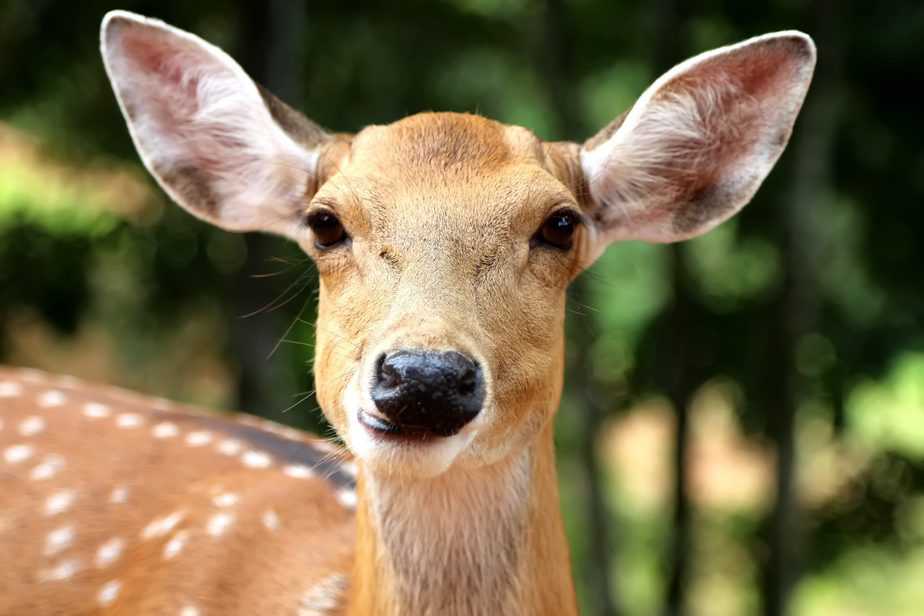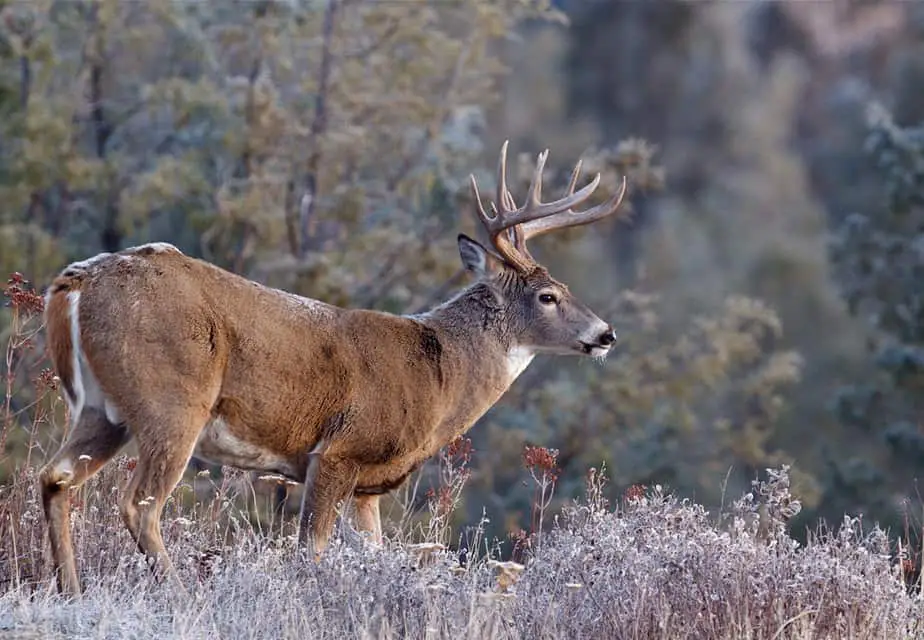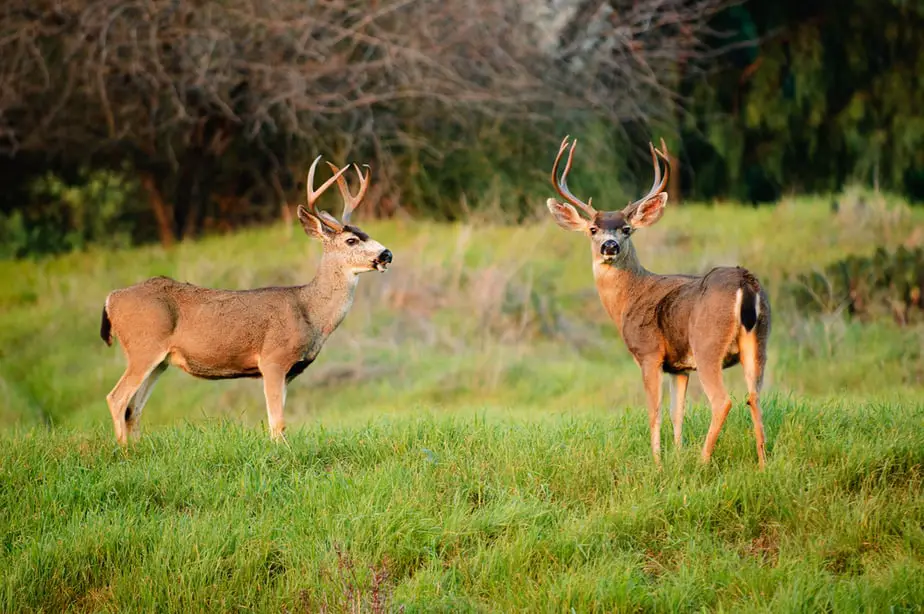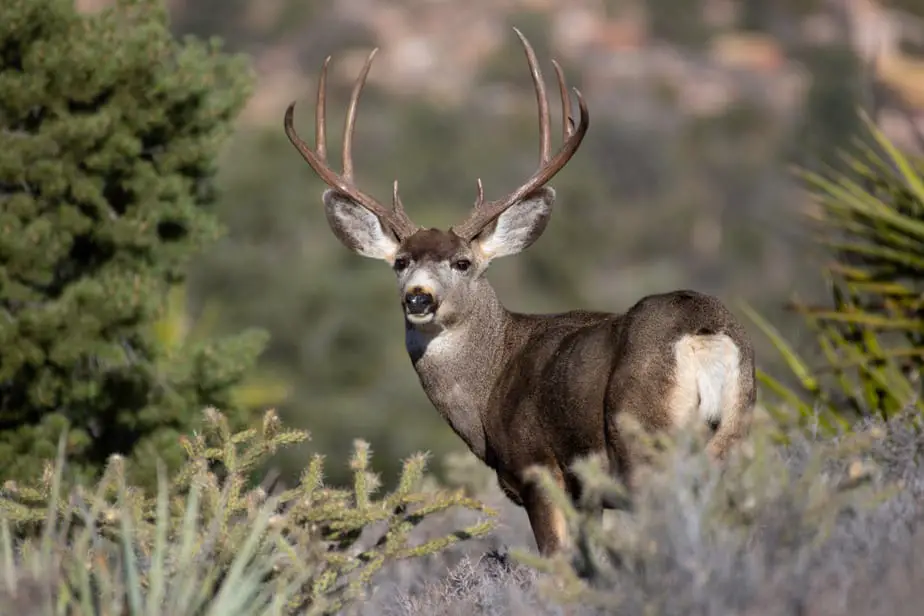If you live in the countryside, there’s no question that you see all kinds of critters mosey into your yard, but if deer isn’t one of them, you may be wondering of ways you can attract them. Deer are stunning wildlife that are always neat to see, so if you’re looking to see more of them at home, stick around; because in this article, we’ll be providing a guide for how to attract deer to your yard!

Table of Contents
The Benefits of Attracting Deer to Your Yard
Surrounding ourselves with nature has been proven to help us feel more calm, relaxed, and happy; and attracting deer to your yard is an excellent way to bring nature right to your backdoor! Believe it or not, there are actually quite a few benefits to having deer in your yard, such as…
- Feeding deer is a great learning experience for the whole family. Today’s world, and particularly children, are further away from nature and outdoor learning experiences than ever before. Having deer in your backyard is a great way to give the whole family a unique learning experience that many families don’t get to experience.
- You’ll be providing food for the local wild deer population. Food can be scarce, and especially during the winter season, so by enticing hungry deer to your property, you’ll be providing a constant supply of food to the local deer population.
- They can keep the growth of plants in control. While this can be a downside (that we’ll discuss in the next section), deer eating plants around your home can actually serve a good purpose! If you have lots of woody areas around the outskirts of your property, especially areas full of thick, unmanageable brush, deer can gnaw through these areas and clear them out.
- Deer are beautiful and give your yard a soothing ambiance. Studies show that being around nature makes us happier and less stressed. Having wildlife, like deer, in your backyard can bring you closer to nature and bring a feeling of relaxation and beauty to your yard.
The Downside to Having Deer in Your Yard
While there are worthwhile benefits to attracting deer to your yard, there are a few downsides to consider, as well. These include:
- Your gardens may be ravished. Depending on what kind of foliage you have in your yard, deer may come through and ravish your gardens. Deer will eat hostas, daylilies, evergreen plants, and any edible plants that you may have in your vegetable gardens. Luckily, there are ways that you can prevent deer from ruining your plants.
- Your bird feeders may be torn down. Deer have not only been known to go after gardens but also after bird feeders. If you have a bird feeder that openly holds seeds without a grate or other form of protection, deer will find their way to get to the seeds — even if that means breaking your feeders. Ensure that you place your bird feeders where deer can’t reach them, approximately 8 to 10 feet above the ground. Larger deer can stand up to 7 feet tall, and are able to stretch their necks out higher than that.
- They can pose a threat to pets and children. Both male and female deer can weigh between 100 and 200 pounds (or more) and will physically attack pets and children that get too close for comfort. When threatened, deer will ram victims with their antlers, or rear up on their hind legs and hit the pet or person with their front hooves and legs. When inviting deer to your property, you’ll want to fence pets and keep an eye on children whenever they’re outside to avoid potential injury.
- They’re more likely to get hit by/run out in front of a car on the roads next to your home. Every year, there are approximately 1 million car collisions with deer that end in the death of 400 people, and result in tens of thousands of serious injuries. As you can see, deer are already prone to getting hit by cars and causing accidents in woody areas, and the probability of a deer-car accident increases when you invite them to your neighborhood. If you live very rurally, this may not be as big of an issue. However, if you live closer to highways or other highly populated areas, you may want to reconsider inviting deer to your backyard.
- There are potential health risks involved. Deer come with a whole host of diseases, including Lyme Disease, that originates from the many ticks that feed on the blood of deer. A deer that brings ticks infected with Lyme Disease closer to your home, increases the potential of the diseased tick infecting you, your family members, and your neighbors.
How to Attract Deer to Your Yard
Now that you know the benefits and risks of attracting deer to your yard, let’s jump into how to attract deer to your yard! Attracting deer isn’t as difficult as some may think it is, and really only falls down to a few backyard adjustments.
1. Provide an Efficient Water Source
Having a horse or cow trough, a pond, or any other large freshwater source will make deer searching for water more likely to come to your property. Deer coming to backyard water sources is especially common during the summer when the temperatures are very hot and natural water is scarce, or in areas where winters are particularly harsh and water freezes over.
During the winter, if your backyard water sources are expected to freeze over, you may want to consider investing in a trough heater or place a block of wood in the water source to prevent it from freezing.
2. Provide a Food Source for Deer
- Gravity-driven trough design
- Durable, UV-resistant plastic construction
- 40 lb. Capacity
- Strap for Tree or post mounting included
- No batteries or programming required
Last update on 2025-03-28 / Affiliate links / Images from Amazon Product Advertising API
If there’s one thing that will attract deer to your yard, it’s food.
The best way to feed deer is with a tree-mounted gravity feeder. These feeders are generally affordable, and are gravity-driven, meaning they don’t require batteries or other mechanics to dispense food to the deer. The Moultrie Feed Station shown above is UV-resistant and protects the feed from the elements. It can also hold up to 40 pounds of feed.
Commercial deer feed will usually consist of grains and corn. We recommend that you choose organic or Non-GMO corn or feed to avoid feeding your local deer anything that contains nasty chemicals, fillers, preservatives, or other unnatural ingredients.
Our favorite deer feed is the Farmer’s Blend Ernst Grain feed made with Non-GMO corn to keep deer not only happy and full, but healthy.
Last update on 2025-03-28 / Affiliate links / Images from Amazon Product Advertising API
3. Tie a Salt Lick on a Low Limb
- Premium Natural Himalayan Salt Lick: Sourced from the Himalayan Mountains, our 100% natural salt lick contains 84 trace minerals in this natural rock. With no preservatives or additives, it provides a pure and natural source of essential minerals, replenishing lost electrolytes for the well-being of horses, deer, goats, cows, livestock, cats, and dogs.
- Essential Mineral Supplies: These Himalayan salt blocks contain up to 84 trace minerals, including vital nutrients like Calcium, Magnesium, Potassium, and Iron. These mineral supplies are essential for the overall health and well-being of your animals, including horses, deer, goats, cows, donkeys, cats, dogs, and all other livestock.
- Versatile Treat for Various Animals: Our Himalayan salt lick is a natural and nutritious treat that animals love. It serves as a beneficial treat for horses, deer, goats, cows, donkeys, cats, dogs, and all other livestock, providing them with essential minerals and a flavorful indulgence.
- Adjustable Rope for Perfect Height & Lasting Durability: Our Salt on a Rope features a sturdy and long rope, providing optimal positioning and exceptional durability that outlasts nylon or cotton alternatives. As a natural rock, our Salt on a Rope will last 3 times longer than a pressed salt lick, ensuring a reliable and long-lasting salt lick experience.
- Versatile and Enjoyable Toy: Our salt lick provides hours of entertainment and enrichment for horses, deer, goats, cows, all other livestock, cats, and dogs. It serves as a great toy that keeps your animals engaged and satisfied. This Salt Lick imported is 6 lb Actual size may vary between 5 lbs and 6 lbs.
Last update on 2025-03-28 / Affiliate links / Images from Amazon Product Advertising API
Deer aren’t attracted to salt licks only for the taste, but for the health benefits that salt provides! Salt is an essential nutrient for deer and helps to aid in their digestion. By providing this supplemental feeding to deer, you’ll be helping them to stay healthy, giving them a yummy treat, and attracting lots of the herd to your yard!
The above Himalayan sea salt lick is our preferred option because it’s natural and doesn’t contain anything harmful to deer or other wildlife that may find salt appealing. For more information on how to choose a salt lick for deer, check out this informative article from FeedthatGame.com!
4. Apply Deer Urine Around Your Property
- Won't wash away in the rain
- Won't dry out in the wind
- Use during pre-rut and rut seasons
- Shoots a 10 gel foot stream
Last update on 2025-03-28 / Affiliate links / Images from Amazon Product Advertising API
Deer urine has been used by hunters for generations to attract deer to their preferred hunting sites. A deer attractant, such as deer urine, gives off a familiar scent that makes other deer more comfortable coming closeby. By applying deer urine to the areas of your property that you want to invite deer, you’ll be providing your backyard with a more deer-friendly scent.
Keep in mind that this article is for attracting deer for visual pleasure, and not for sport or meat. We do not advise that you use deer urine for hunting unless you have confirmed that it is legal in your state. Some states, such as Minnesota and Pennsylvania have outlawed these practices as unnatural. For more on hunting deer and the legality of it, check out this guide on if you can hunt deer in your backyard.
The Kind of Deer You Might See
Typically, in North America and the United States, you’ll see one of three kinds of deer: White-Tailed Deer, Black-Tailed Deer, and Mule Deer. So now that you know how to attract deer to your yard, in this section, we’ll be taking a look at the most common deer species that may wander up in your backyard!
1. White-Tailed or Whitetail Deer

White-Tailed or Whitetail Deer are found all over the United States, up into Canada, and down into Mexico and lower North America. These deer are distinguished by the white underside of their tails. These deer are generally reddish-brown in color or bluish-gray.
- White-Tailed bucks are generally 150 to 200 pounds with antlers that can span up to 16 feet, including tines. Their antlers consist of one main branch with tines that extend out from the main branch.
- Whitetail Does are around 100 pounds when fully grown, and typically don’t display any antlers. However, if there are hormonal imbalances present, a doe may develop small, unhardened antlers. You’ll usually find them with fawns or other does.
- When White tailed deer are alarmed, they will raise their tails, exposing the white “flag” underneath.
Whitetail deer can be anywhere from 3.5 to 7 feet in length from head to tail, depending on their age and if they are male or female.
2. Black-Tailed Deer

Black-Tailed Deer are mainly found along the Pacific coast and are common in California, up through Alaska. These deer are smaller in size compared to Mule deer and are distinguished by their black tails.
- Blacktail Bucks are typically around 150 to 200 pounds. Bucks have antlers that begin growing at around 8 months old. They’ll begin shedding their velvet once the antlers are fully developed during adulthood. The antlers will grow yearly and expand with tines.
- Blacktail Does are generally around 100 pounds but can weigh up to 130 pounds. Female Black-tailed deer do not have antlers and are generally seen with fawns in the spring and summer months.
These deer are quite reclusive and aren’t seen too often in the deep forests of the Pacific coast, but may visit a rural home with lots of brush coverage.
3. Mule Deer

Mule deer are the largest of the three most common deer species in the United States. Like Whitetail deer, mule deer are generally reddish-brown or bluish-gray in color. Their color depends on the season, and during the summer, their coats lean towards a reddish color. In the winter, they become duller in appearance.
- Mule deer bucks can weigh between 130 and 330 pounds, depending on their age and health. A male Mule deer’s antlers are even overall with leaner tines. Male Mule Deer often have wider heads than other deer species and broader bodies than the Whitetail or Blacktail deer.
- Mule deer does weigh between 95 and 200 pounds, also depending on their age and health. Female mule deer do not have antlers.
Mule deer are distinguished by their large ears in comparison to the size of their heads, giving them their name. While these deer look similar to Whitetail deer, their tails are generally a creamy white in color, without brown (like the Whitetail deer have).
Final Thoughts
In this article, we’ve covered the pros and cons of attracting deer to your yard, how to attract deer to your yard using 4 foolproof methods, and the three most common kinds of deer you might encounter! When it comes to attracting deer, the best way to go about it is by providing a constant food and water source, especially near the edges of woody areas on your property.
Attracting deer to your yard is an excellent learning experience and an overall unique natural feature to have in your yard! We hope our guide has helped you to make your backyard more deer friendly!



